This article is intended to guide agricultural professionals in using cover crops for management of root-knot nematodes.
Nematodes are unsegmented roundworms belonging to the phylum Nematoda. Nematodes are found in almost all habitats, but they are often overlooked due to their microscopic size. Many different kinds of nematodes are present in soil (McSorley 2019). These include plant parasites, decomposers, predators, insect parasites, and animal parasites. Some nematodes are aquatic and do not affect terrestrial plants. In farming systems, nematode predators and nematodes that are parasites of insects are beneficial, while nematode parasites of plants and animals are pests. Entomopathogenic nematodes (nematodes harmful to insects) may help to reduce the number of insect pests by infecting them with bacteria. Plant-parasitic nematodes will mainly feed on plant roots, and they can seriously damage or even kill crops, turf, and ornamental plants. Plant-parasitic nematodes are difficult to control because they live underground or inside the plant roots.
One of the most damaging groups of plant-parasitic nematodes is the root-knot nematodes (Meloidogyne spp.). These nematodes are widespread and are pests of almost all major crops. Damage by root-knot nematodes can be seen as galls or knot-like swellings produced along the plant roots (Figure 1). These galls cannot be easily removed because they are part of the plant root tissue. The juvenile root-knot nematode is the infective stage that can freely move through the soil and enter the root of a suitable host plant. Root-knot nematodes establish feeding sites within plant roots and cause enlargement of root cells. Only the females are capable of establishing feeding sites. A root-knot nematode infestation can be detected by the presence of their galls on plant roots. Several different species of root-knot nematodes occur in Florida, and a few of these occur as different host races, or specialized subgroups defined by the set of crops they infect. It is extremely difficult to differentiate between different species or races of root-knot nematodes, but a professional nematology diagnostic service such as the UF/IFAS Nematode Assay Lab can identify them for you (https://entnemdept.ufl.edu/nematology-assay-lab/).
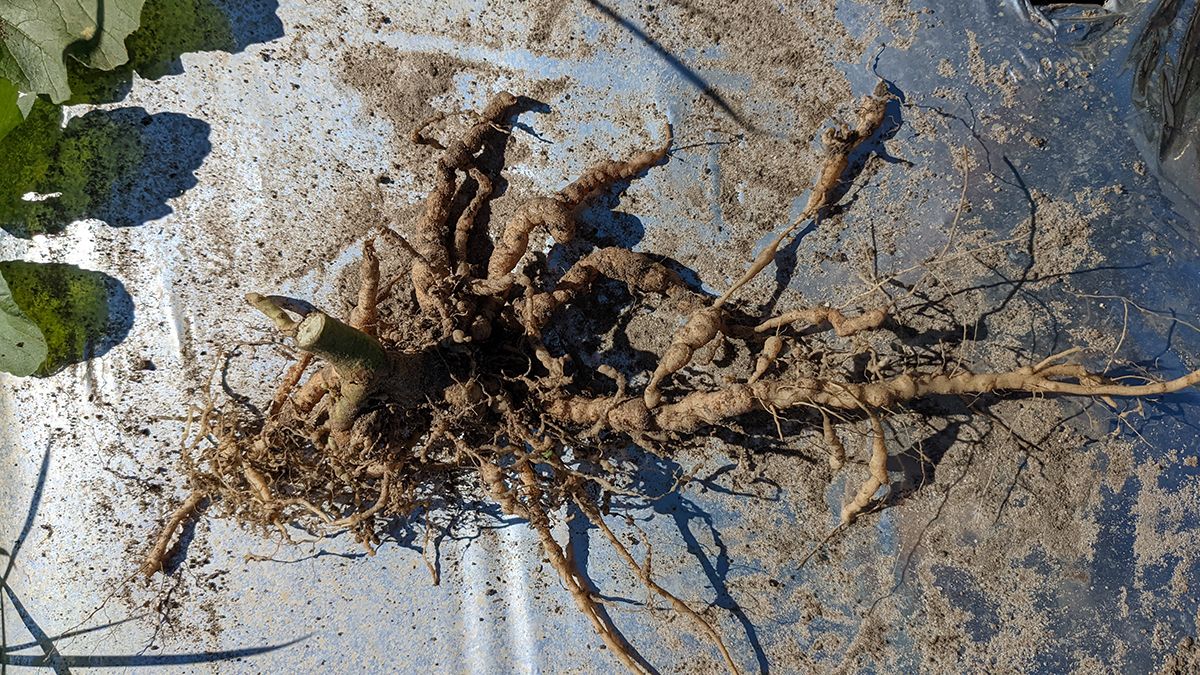
Credit: Zane Grabau, UF/IFAS
Cover Crops
Cover crops are crops grown between cash crop cycles or incorporated with cash crops to cover the ground in vegetable fields, orchards, and agricultural sites. Cover crops are mainly planted to improve soil fertility and soil structure; decrease soil erosion; and suppress weeds, insects, nematodes, and other plant pathogens. Residues from cover crops can be incorporated as “green manure” to supply macro- and micronutrients for increasing the soil fertility for the next crop. Cover crops also help to enhance many beneficial organisms, and also possibly contribute to carbon sequestration. Cover crops are useful in nematode management because nematodes can move only very short distances on their own. Nematodes cannot migrate to another field if a cover crop is not a host to the nematodes. Instead, some of them may starve, which helps to manage their population. Fallow soil also helps to keep nematode populations at lower levels, but it may lead to soil erosion and other problems. Many different types of cover crops are adapted for cultivation in the southern United States. Popular cover crops are cowpea (Vigna unguiculata), sorghum-sudangrass (Sorghum bicolor × S. sudanense), sunn hemp (Crotalaria juncea), marigolds (Tagetes spp.), jointvetch (Aeschynomene americana), sesame (Sesamum indicum), grasses, rye (Secale cereale), wheat (Triticum aestivum), oats (Avena sativa), crimson clover (Trifolium incarnatum), vetch (Vicia spp.), and lupine (Lupinus angustifolius). Today, there is an interesting trend toward using legumes as cover crops because they supply nitrogen to subsequent crops or can be used as high-quality forage in silage production (Hartwig and Ammon 2002).
Summer Cover Crops
Cowpea, sunn hemp, sorghum-sudangrass, marigold, jointvetch, hairy indigo (Indigofera hirsuta), sesame, and some grasses have most commonly been used as summer cover crops to keep root-knot populations at lower levels.
COWPEA
Cowpea is well adapted for cultivation in the tropics and southern United States. Cowpea is a leguminous summer cover crop (Figure 2) and helps to fix free atmospheric nitrogen with the help of nitrogen-fixing bacteria. Nematode management using a cowpea cover crop is dependent on the type of cowpea cultivar used and the type of nematode present. Cultivars such as ‘Mississippi Silver’ and ‘Iron Clay’ were found effective against different species of Meloidogyne incognita (southern root-knot nematode). Some cultivars are susceptible to southern root-knot nematode or other species of root-knot nematodes and may increase nematode populations. Therefore, consideration of the cowpea cultivar used and nematode species in a particular field is important in order to avoid compounding nematode problems. For more information on cowpea cover crops for root-knot nematode management, see “Management of Nematodes with Cowpea Cover Crops” (Wang et al. 2021).
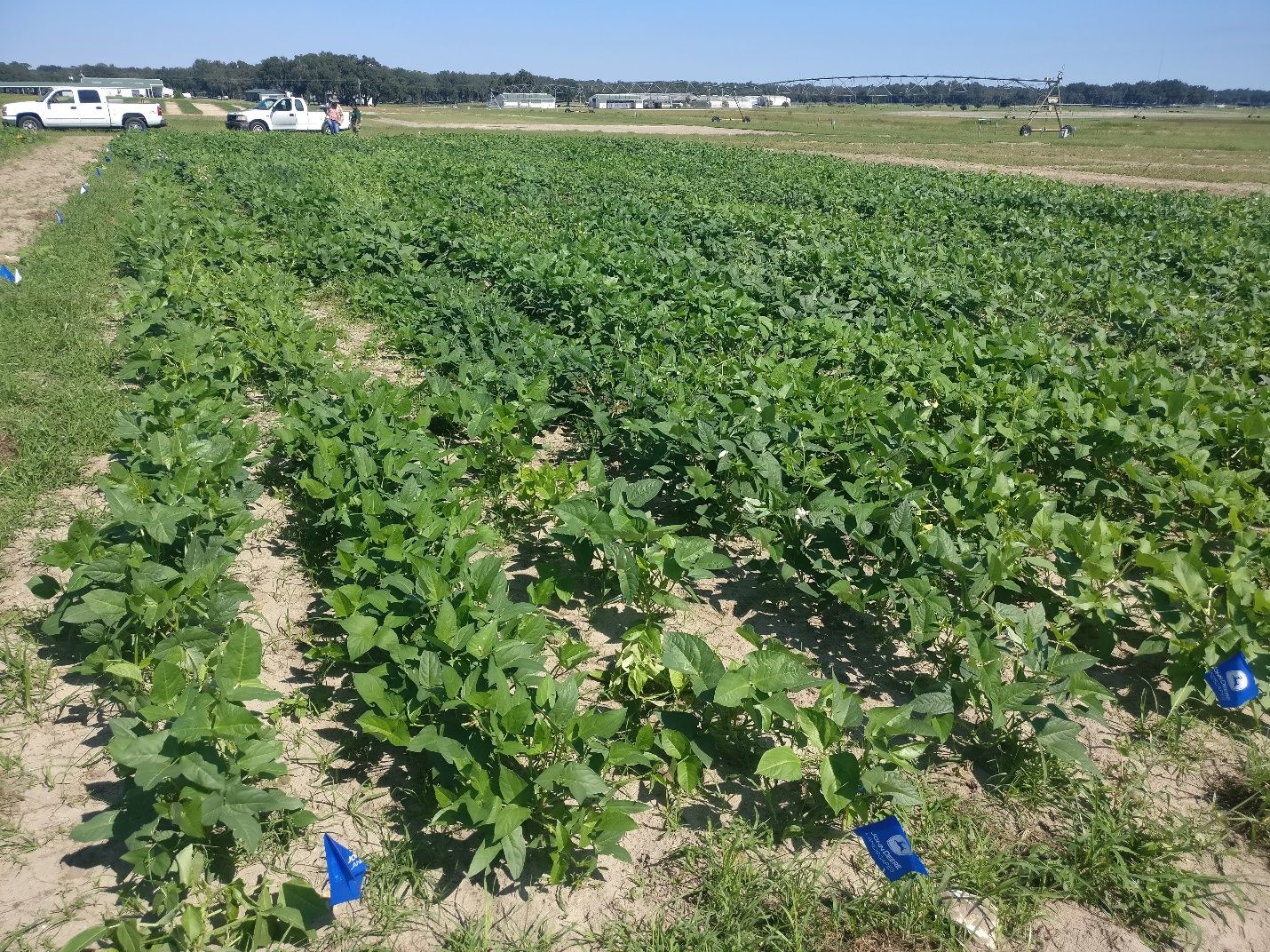
Credit: Esteban Rios, UF/IFAS
SUNN HEMP
Sunn hemp is being used more and more often as a summer legume cover crop in the southern United States (Figure 3). This versatile crop helps to suppress weeds, reduce soil erosion, and reduce populations of most root-knot nematodes and reniform nematodes (Rotylenchulus reniformis), among other nematodes. Besides suppressing nematodes, sunn hemp is beneficial because its crop residues help to improve soil organic matter and crop vigor and health. For more information on sunn hemp cover crops for root-knot nematode management, see “Management of Nematodes and Soil Fertility with Sunn Hemp Cover Crops” (Wang et al. 2022).
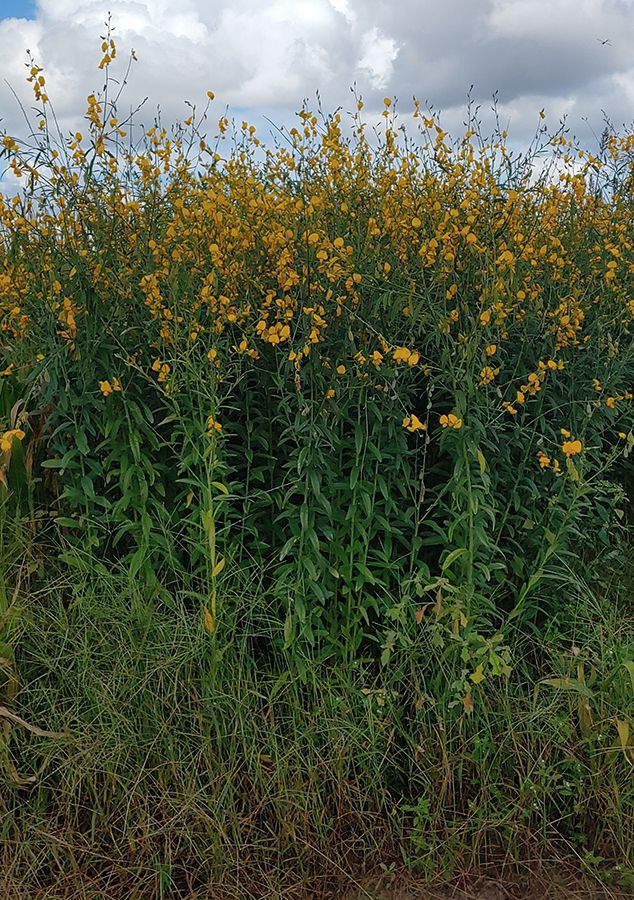
Credit: Zane Grabau, UF/IFAS
SORGHUM-SUDANGRASS
Although sorghum-sudangrass is a summer crop (Figure 4), it can be planted year round in central and south Florida. Sorghum or sorghum-sudangrass are most effective at managing root-knot nematodes when they are used as rotation crops. In a Florida research study (McSorley et al. 1994), ‘SX-17’ sorghum-sudangrass did not support populations of southern root-knot nematode races 1 and 2, peanut root-knot nematode race 1 (M. arenaria), and Javanese root-knot nematode (M. javanica). Thus, it was effective against a wide range of root-knot nematodes that are common in Florida. Some varieties of sorghum-sudangrass are not only poor hosts for root-knot nematodes but may be resistant to some plant diseases and insect pests. As with cowpea, cultivar choice can be critical. For more information on sorghum-sudangrass cover crops for root-knot nematode management, see “Nematode Management Using Sorghum and Its Relatives” (Dover et al. 2021).
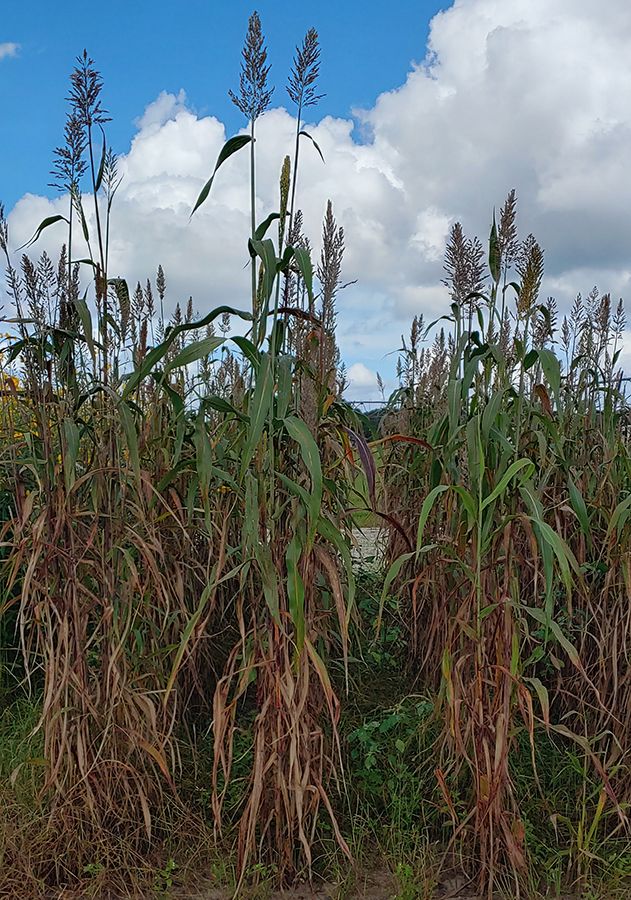
Credit: Zane Grabau, UF/IFAS
MARIGOLD
Marigold (Tagetes spp.) can be used as a cover crop (Figure 5) and it also produces an allelochemical called alpha-terthienyl, which helps to reduce populations of root-knot nematodes and may have activity against other plant pests such as fungi, bacteria, and insects (Hooks et al. 2010). Marigold can suppress 14 genera of plant-parasitic nematodes, especially root-knot nematodes and lesion nematodes (Pratylenchus spp.). Different species and cultivars of marigold vary in their ability to suppress nematode populations. For more information on marigold cover crops for root-knot nematode management, see “Marigolds (Tagetes spp.) for Nematode Management” (Krueger et al. 2019).

Credit: UF/IFAS
OTHER SUMMER COVER CROPS
Some other crops such as jointvetch (Figure 6), horsebean (Canavalia ensiformis) (Figure 7), sesame (Figure 8), and some grasses can be also used as cover crops to manage populations of root-knot nematodes (Table 1). Weeds such as hairy indigo (Indigofera hirsuta), partridge pea (Cassia fasciculata), and showy crotalaria (Crotalaria spectabilis) (Figure 9) have also been used (Table 1). Several of the cover crops, including cowpea, sorghum-sudangrass, jointvetch, and castor were found effective to reduce more than one species or race of root-knot nematodes in Florida, but results depend on crop cultivars and nematodes species or races (McSorley et al. 1994). An alternative cropping system incorporating bahiagrass (Paspalum notatum) into row crops has also been developed, and it may be helpful for managing root-knot and other nematodes (Wright et al. 2018).
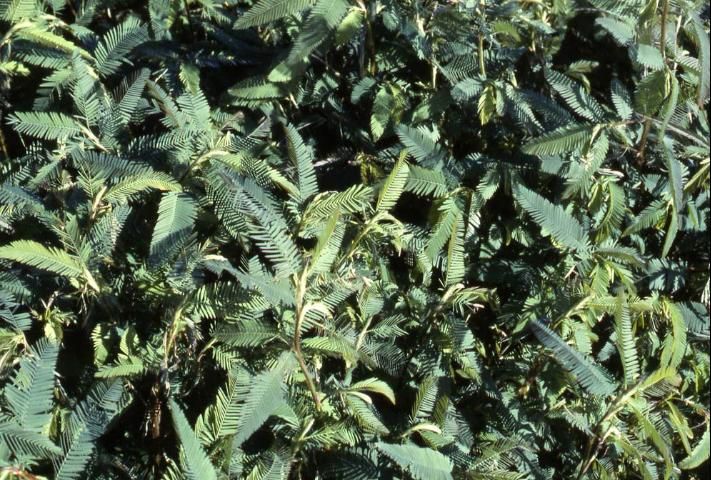
Credit: UF/IFAS
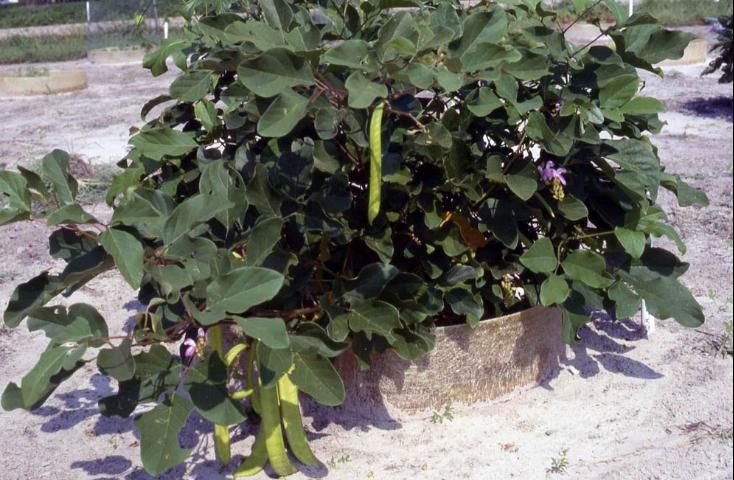
Credit: UF/IFAS

Credit: UF/IFAS
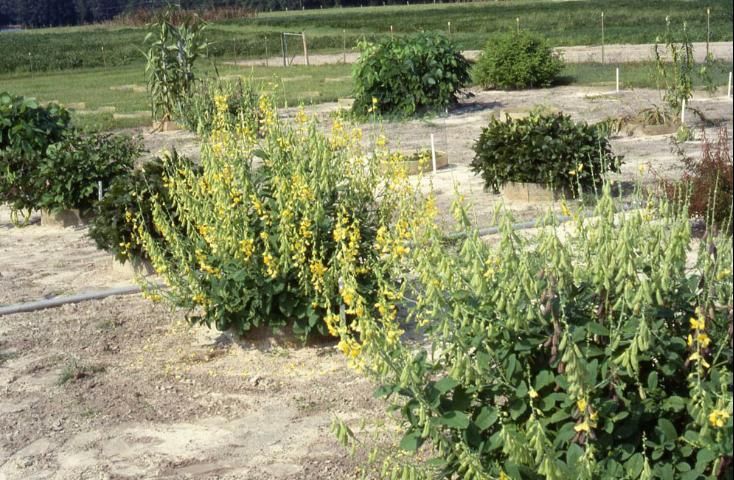
Credit: UF/IFAS
Winter Cover Crops
Winter cover crops such as rye (Secale cereale) (Figure 10), wheat (Triticum aestivum) (Figure 11), crimson clover (Trifolium incarnatum) (Figure 12), and lupine (Lupinus angustifolius) (Figure 13) are used where summer is the main cropping season (Wang et al. 2004). Rye is a commonly used winter cover crop in the southeastern United States and a poor host of root-knot nematode species (McSorley and Dickson, 1989). Population densities of southern root-knot nematode remained low throughout the winter cover-cropping season on several crops (wheat, rye, oat, lupine, hairy vetch (Vicia villosa), and crimson clover). However, their numbers increased after a susceptible corn crop was planted in the spring (Table 2), especially following legumes, hairy vetch, crimson clover, and lupine (Wang et. al. 2004). Leguminous cover crops are important for providing nitrogen, but most winter legumes can increase population levels of root-knot nematodes, and hairy vetch and crimson clover are particularly troublesome, with hairy vetch also not recommended due to its high potential for becoming invasive in Florida. Some cultivars of winter legumes show promise in nematode management. ‘Cahaba’ White vetch (Vicia sativa) was reported effective in managing M. incognita race 3 in a greenhouse experiment conducted in Georgia (Timper et al. 2006). ‘Cherokee’ red clover (Trifolium pratense) had reduced root galling and nematode reproduction compared to other germplasm of red clover in response to peanut root-knot nematode, northern root-knot nematode (M. hapla), southern root-knot nematode, and Javanese root-knot nematode (Quesenberry et al. 1989). Rye and oat were most effective in keeping nematode numbers low, and in general, cereal cover crops are better than leguminous cover crops for nematode suppression (Wang et al. 2004) (Table 2).
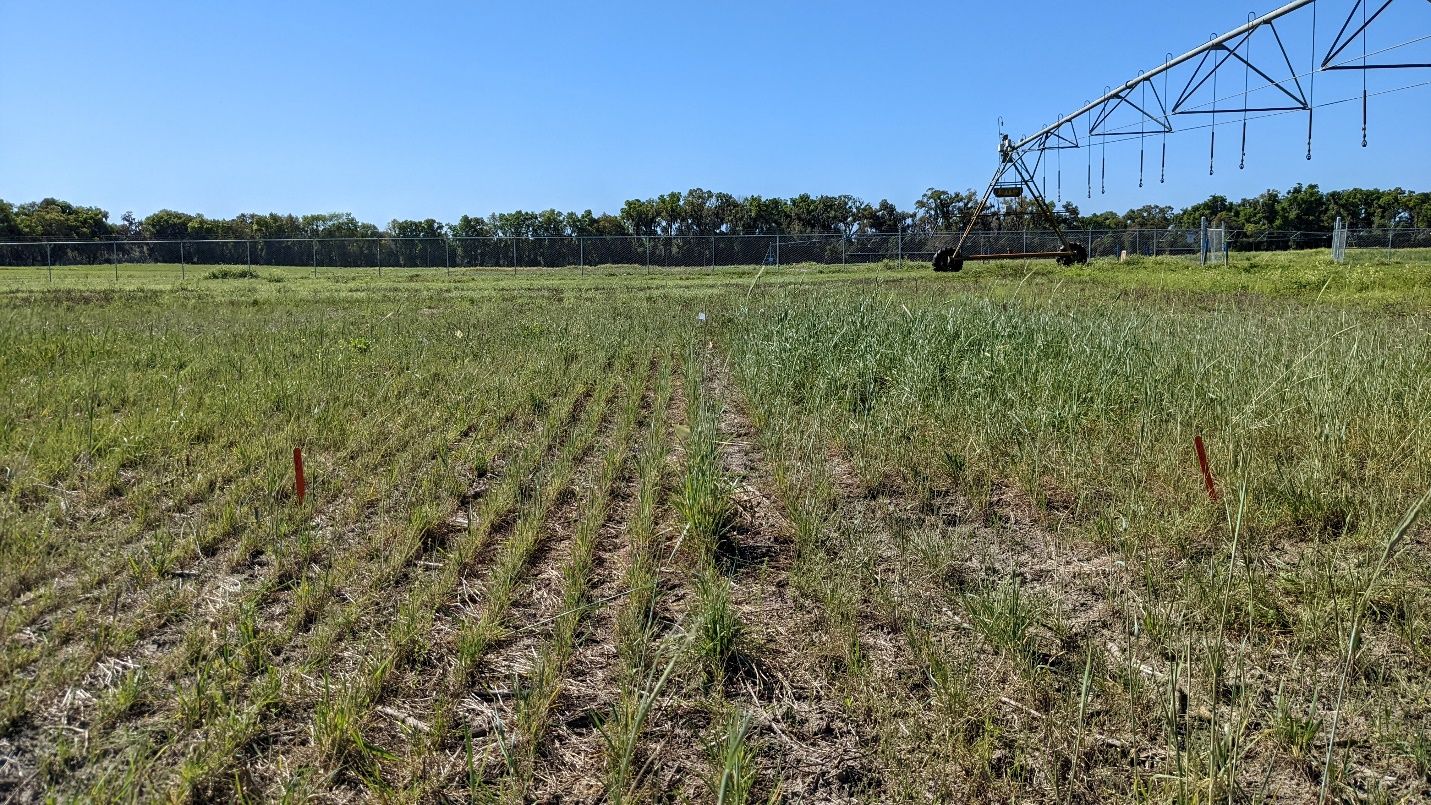
Credit: Zane Grabau, UF/IFAS
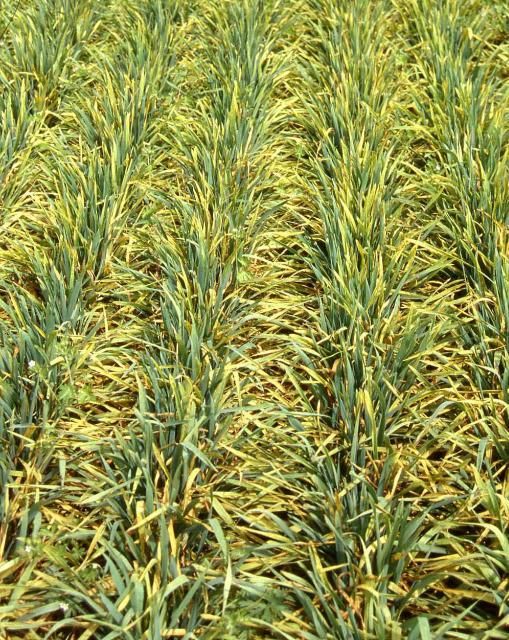
Credit: UF/IFAS
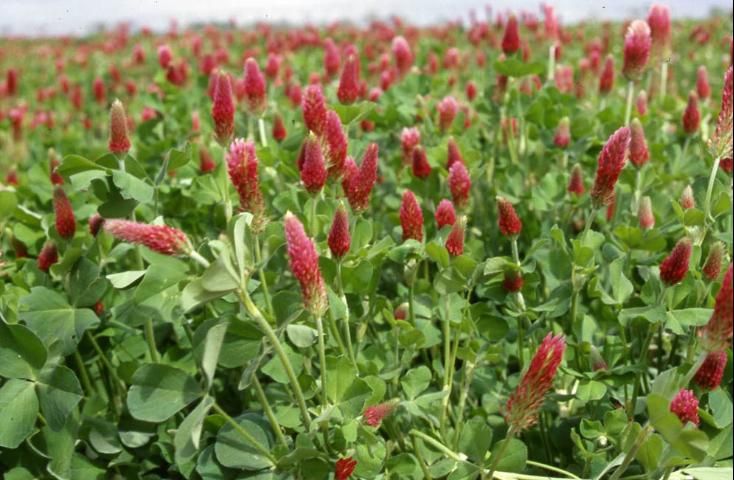
Credit: UF/IFAS
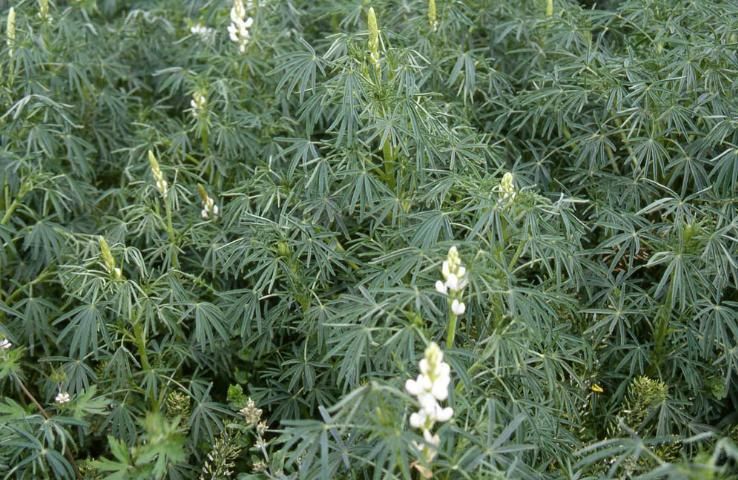
Credit: UF/IFAS
Conclusions
Cover crops may be used for many different reasons, and some may be helpful for managing root-knot nematodes. However, use of some cover crops may have both advantages and disadvantages. Crops such as crimson clover are legumes that provide a nitrogen supply, but they also encourage populations of root-knot nematodes over the winter time (McSorley and Dickson 1989). Velvetbean can produce dense vines and become hard to manage, and it can also act as a host plant for some insect pests. Some of these plants discussed as “cover crops,” such as hairy indigo and “showy” crotalaria, are considered weeds in Florida and cannot be recommended. Similarly, some plants previously considered cover crops and tested for nematode management, such as hairy vetch, castor (Ricinus communis), and velvetbean (Mucuna pririens) present a high risk of becoming invasive and must be avoided. Use UF/IFAS’s plant assessment tool to determine if a cover crop represents a risk of invasion. Additional care in selecting a cover crop must also be made if livestock will graze the area, as some cover crops, such as some crotalaria species, castor, and sudangrass, can be toxic to livestock (McSorley et al. 1994). Weed management is also important to discourage root-knot nematode populations in cover crops. In prior research in Florida, poor cover crop stand due to seedling diseases and defoliation by caterpillars led to weed development in cover crop research plots. Some of these weeds were nematode hosts and showed galling from M. incognita (Crow et. al. 2001). Presence of these weeds made the cover crop ineffective for nematode management. Even when cover crops are used successfully, it is important to know that nematodes can recover after a susceptible host is grown, so crop rotation should be done on a continuing basis to avoid buildup of nematode populations. Depending on the target cash crop and production setting, there are some other management options for nematodes such as solarization (Krueger and McSorley 2018), nematicide application (Grabau 2020), and planting resistant cultivars, which are also effective for managing root-knot nematodes to some extent.
References
de Brida, A. L., B. M. D. E. Castro, J. C. Zanuncio, J. E. Serrao, and S. R. S. Wilcken. 2018. “Oat, Wheat and Sorghum Cultivars for the Management of Meloidogyne enterolobii.” Nematology 20:169–173. https://doi.org/10.1163/15685411-00003131
de Brida, A. L., E. C. S. D. Correia, B. M. D. E. Castro, J. C. Zanuncio, and S. R. S. Wilcken. 2017. “Oat, Wheat, and Sorghum Genotype Reactions to Meloidogyne incognita and Meloidogyne javanica.” Journal of Nematology 49:386–389. https://doi.org/10.21307/jofnem-2017-086
Carneiro, R. M. D. G., V. M. de Freitas, J. K. Mattos, J. M. C. Castro, C. B. Gomes, and R. G. Carneiro. 2012. “Major Guava Nematodes and Control Prospects using Resistance on Psidium spp. and Non-host Crops.” Acta Horticulturae 959:41–49. https://doi.org/10.17660/ActaHortic.2012.959.4
Crow, W. T., D. P. Weingartner, D. W. Dickson, and R. McSorley. 2001. “Effect of Sorghum-sudangrass and Velvetbean Cover Crops on Plant-parasitic Nematodes Associated with Potato Production in Florida.” Supplement to the Journal of Nematology 33:285–288.
Dover, K., K. -H. Wang, Z. J. Grabau, and R. McSorley. 2021. “Nematode Management Using Sorghum and Its Relatives.” ENY-716/IN531. EDIS 2021 (6). https://doi.org/10.32473/edis-IN531-2021
Grabau, Z. J. 2020. “Fumigant and Nonfumigant Nematicides Labeled for Agronomic Crops in Florida.” ENY-065/IN1152. EDIS 2020. https://edis.ifas.ufl.edu/publication/IN1152
Guertal, E. A., E. J. Sikora, A. K. Hagan, and R. Rodriguez-Kabana. 1998. “Effect of Winter Cover Crops on Populations of Southern Root-knot and Reniform Nematodes.” Agriculture, Ecosystems, and Environment 70:1–6. https://doi.org/10.1016/S0167-8809(97)00105-9
Hamidi, N., and A. Hajihassani. 2020. “Differences in Parasitism of Root-knot Nematodes (Meloidogyne spp.) on Oilseed Radish and Oat.” Journal of Nematology 52:e2020–43. https://doi.org/10.21307/jofnem-2020-043
Hartwig, N. L., and H. U. Ammon. 2002. “Cover Crops and Living Mulches.” Weed Science 50:688–699. https://doi.org/10.1614/0043-1745(2002)050[0688:AIACCA]2.0.CO;2
Hooks, C. R. R., K. -H. Wang, A. Ploeg, and R. McSorley. 2010. “Using Marigold (Tagetes spp.) as a Cover Crop to Protect Crops from Plant-parasitic Nematodes.” Applied Soil Ecology 46:307–320. https://doi.org/10.1016/j.apsoil.2010.09.005
Ibrahim, I. K. A., S. A. Lewis, and D. C. Harshman. 1993. “Host Suitability of Graminaceous Crop Cultivars for Isolates of Meloidogyne arenaria and M. incognita. Supplement to Journal of Nematology 25:858–862.
Khanal, C., and D. Harshman. 2022. “Evaluation of Summer Cover Crops for Host Suitability of Meloidogyne enterolobii.” Crop protection 151: article 105821. https://doi.org/10.1016/j.cropro.2021.105821
Krueger, R., K. E. Dover, R. McSorley, and K. -H. Wang. 2019. “Marigolds (Tagetes spp.) for Nematode Management.” ENY-056/NG045. EDIS 2019. https://edis.ifas.ufl.edu/publication/ng045
Krueger, R., and R. McSorley. 2018. “Solarization for Pest Management in Florida.” ENY-902/IN824. EDIS 2018. https://edis.ifas.ufl.edu/publication/in824.
Machado, A. C. Z., S. A. Silva, O. F. Dorigo, C. R. Riede, and D. D. Garbuglio. 2015. “Phenotypic Variability and Response of Brazilian Oat Genotypes to Different Species of Root-knot and Root-lesion Nematodes.” Europena Journal of Plant Pathology 141:111–117. https://doi.org/10.1007/s10658-014-0529-z
McSorley, R. 1999. “Host Suitability of Potential Cover Crops for Root-knot Nematodes.” Journal of Nematology 31:619–623.
McSorley, R. 2019. “Soil-Inhabiting Nematodes, phylum Nematoda.” ENY-0012/IN138. EDIS 2019. https://edis.ifas.ufl.edu/publication/in138
McSorley, R., and D. W. Dickson. 1989. “Nematode Population Density Increase on Cover Crops of Rye and Vetch.” Nematropica 19:39–51.
McSorley R., D. W. Dickson, and J. A. de Brito. 1994. “Host Status of Selected Tropical Rotation Crops to Four Populations of Root-knot Nematodes.” Nematropica 24:45–53.
Mosjidis, J. A., R. Rodriguez-Kabana, C. F. Weaver, and P. S. King. 1994. “Reaction of Nine Vicia Species to Meloidogyne arenaria Race 2 and Heterodera glycines Race 4.” Nematropica 24:1–5.
Quesenberry, K. H., D. D. Baltensperger, R. A. Dunn, C. J. Wilcox, and S. R. Harry. 1989. “Selection for Tolerance to Root-knot Nematodes in Red Clover.” Crop Science 29:62–65. https://doi.org/10.2135/cropsci1989.0011183X002900010014x
Rodriguez, M. G., L. Sanchez, and J. Rowe. 2003. “Host Status of Agriculturally Important Plant Families to the Root-knot Nematode Meloidogyne mayaguensis in Cuba.” Nematropica 33:125–130.
Rosa, J. M. O., J. N. Westerich, and S. R. S. Wilcken. 2015. “Meloidogyne enterolobii Reproduction on Vegetable Crops and Plants Used as Green Manure.” Revista Ciencia Agronomica 46:826–835. https://doi.org/10.5935/1806-6690.20150071
Timper, P., R. F. Davis, and P. G. Tillman. 2006. “Reproduction of Meloidogyne incognita on Winter Cover Crops used in Cotton Production.” Journal of Nematology 38:83–89.
Wang, K. -H., R. McSorley, and R. N. Gallaher. 2004. “Effect of Winter Cover Crops on Nematode Population Levels in North Florida.” Journal of Nematology 36:517–523.
Wang, K. -H., R. McSorley, Z. J. Grabau, and E. Rios. 2021. “Management of Nematodes with Cowpea Cover Crops.” ENY-712/IN516. EDIS 2021. https://edis.ifas.ufl.edu/publication/in516
Wang, K. -H., R. McSorley, and Z. J. Grabau. 2022. “Management of Nematodes and Soil Fertility with Sunn Hemp Cover Crop.” ENY-717/NG043. EDIS 2022 (1). https://doi.org/10.32473/edis-ng043-2022
Wright, D. L., J. J. Marois, S. George, and I. Small. 2018. “Sod/Livestock-Based Peanut/Cotton Production System: The Next Generation Conservation Cropping System.” SS-AGR-126/AG258. EDIS 2018. https://edis.ifas.ufl.edu/publication/AG258
Table 1. Response of some summer cover crops to root-knot nematode species based on field and greenhouse tests.
Table 2. Response of winter cover crops to root-knot nematode species in field and greenhouse tests.